Writing “The ‘Dinner and a Show’ Show”
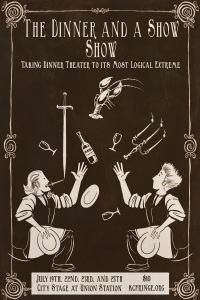
Our gorgeous poster, courtesy of friend and artist Shawn Gaston
This past Summer, Benjamin Domask and I wrote a comedy / juggling / melodrama about two waiters and a rubber lobster. The shows went very well, we had some nice reviews, and even won a “Best of the Fringe” award! A turn of events meant that we had to write the show remotely. many people asked us how we wrote the show, puzzled by the idea of a duo circus show written remotely.
So, friends! Here’s the story-
Last year, I was invited to emcee a series of shows for Kansas City’s “MoonDrop Circus” – a community circus organization that puts on circus productions with local performers all across the city. They brought me in to add some professional flavor from a slightly further afield – after all, Kansas City and Saint Louis are neighbors!
The shows I was to emcee were all part of MoonDrop’s inaugural “Community Circus Week.” This week-long celebration of circus featured workshops and shows every day. They held an Open Stage event in the middle of the week, and were looking for acts. When they asked me if I knew anyone who might be interested, I told them to save a spot for me and my friend Benjamin Domask.
Benjamin and I have known one another for several years through the juggling community. We met at a small juggling festival in Iowa in 2011 and had stayed in touch since then, sending each other videos every once in a while. In a recent conversation, we’d toyed around with maybe working on a piece together. The MoonDrop Open Stage sounded like a good excuse to get together, put something on stage, and see if we partnered well. He drove down from his home in Minneapolis some 18 hours before the Open Stage curtain went up, and we immediately got to work.
The piece we wrote that night is what eventually turned into “The ‘Dinner and a Show’ Show.” It was a silent, volunteer-driven juggling act that featured plate juggling and some rudimentary mouthstick skills. You can see a short demo from our MoonDrop Open Stage show below.
We were encouraged by how well the audience responded to the act, and started talking about expanding it. “Where can we find a stage for it?” “How can we turn ten minutes of mime and juggling into a full hour?” “How can we get together to rehearse?” The answer to these questions seemed to be the Kansas City Fringe Festival.
Neither of us had ever done a Fringe Festival before, but from our friends’ accounts, a Fringe seemed the best place to stage a workshop performance of a circus-waiter-slapstick-clown show. Comparing our calendars, the only festival that didn’t clash with one of our other projects (we still have solo careers to maintain, after all!) was the KC Fringe. By the end of the week, we’d sent in a deposit. We had six months to collaborate on this new project – all the time in the world compared to the 18 hours we had for the last one.
Benjamin and I exchanged lengthy emails about where to take the Fringe show. We knew that it was a clown show, where he was low status and I was high status. We knew it had a food theme, and that our motivation was to serve a volunteer from the audience. We knew we wanted to have that volunteer on stage for over half of the show. We spent the first three months generating ideas to choose from later.
For your edification, here are some ideas that didn’t make it into the Fringe Show, directly from an email I sent to Ben.
– One of us has a helmet with a blender mounted on the top of it. This person is on a pogo stick. There is an extension cord running offstage. Waiter and/or volunteer load up the blender via ladder/fishing rod/robot arm. A smoothie is made. A mess is made.
– Water-pour arm-curl. Walk around a pitcher of water as you pour water into a glass.
– Apples and forks – Somehow, a series of forks skewer a series of apples. Throwing, rolling, etc-ing. Perhaps forks are attached to leather belts that are wrapped around a waiter’s arms?
– Loading up the waiter – A waiter is over-burdened with things in arms, tray, etc. Waiter must go from stage right to stage left without dropping anything. (A few scheduled near-misses are implemented as skills.)
– Restaurant gets swamped with (invisible/imaginary) patrons, waiters scramble to keep up:: nice theatrical moment here where people filter in via background noise – http://www.youtube.com/watch?v=jAg6tyC9Xxc
– Waiters are wearing half-aprons, as is customary in some fancy restaurants. The apron is removed, a vestigial third leg is discovered. (….or something less grotesque?)
– A flower is thrown into a vase from across the stage.
– A waiter is given the phone number of a patron. Waiter decides to pursue a relationship on-the-clock.
– A wine-rack falls horizontally. Waiters must bottle-walk to get from one part of the stage to another.
– Two waiters butcher a chicken // two waiters accidentally serve patron a live chicken.
– A patron orders an egg. The waiters can’t find an egg. They go straight to the source and attempt to coax an egg out of a chicken.
– Pyramid champagne pour – you’ve seen these, yeah? – http://www.youtube.com/watch?v=k-wXLnMTiwY
– Waiters make a sandwich, cigar box style. Stack of ingredients vertically on the ground get integrated into a sandwich like a cigar box slapstack. (Like this, but better… http://www.youtube.com/watch?v=bikubkSZOXs )
– A song is played by blowing on bottles.
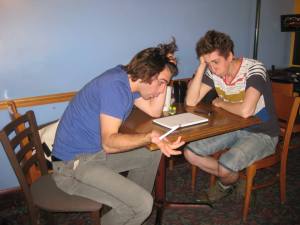
This is what Ben and I looked like when we finally got together and revisited these lists. “What is this crap?!” I exclaim. “I dunno, you’re the one that wrote it,” Ben thinks to himself.
After the idea generation stage, we started carving out a rough narrative arc. The first exercise we tried is fondly referred to as the “children’s storybook drill”, where you take ideas and group them under the title of a chapter in a hypothetical children’s book. Then, you find ways to order those chapters into a rough narrative.
Here are a few chapter titles Benjamin and I came up with through this drill. (Once again, thankfully, very few of these ideas made it to the final edit!)
A SELECTION OF HYPOTHETICAL CHAPTERS FOR THE HYPOTHETICAL ADAPTED CHILDREN’S STORYBOOK OF THE TWO HANDSOME WAITERS’ NEW STAGE PRODUCTION: THE DINNER AND A SHOW SHOW
– The two handsome waiters light a candle
– The two handsome waiters pour a glass of water
– The two handsome waiters set the table
– The two handsome waiters are award-winning sommeliers
– The two handsome waiters use mnemonics to remember the order
– The two handsome waiters demand a tip
– The longest piece of spaghetti
– One-hundred ways to skin a cat
– How to accidentally pour a cup of coffee from across the room
– An accident in the kitchen -or- have you seen my finger?
– A watched pot boils eventually
– “Sorry, we’re fresh out of that” “Sorry, we’re fresh out of that” “Sorry, we’re fresh out of that”
– The two handsome waiters break some eggs
– One angry waiter needs a cigarette break
– How to catch a rat in the kitchen
– The two handsome waiters roll some napkins
– “My soup is cold”
– Two handsome waiters present the bill
– Love tears the waiters apart
– The two handsome waiters kiss the cook
– The two handsome waiters are naked under all of these clothes ((under these aprons?))
Our original plan was to meet up in St Louis with a stack of notecards and bang out a script in person a few months before the Fringe started. However, after sending this last email, I got a phonecall from Cirque du Soleil, inviting me to fill in for a juggler on their show “Totem.” We’d have to finish this project remotely.
Benjamin and I continued sending each other emails. Benjamin took over the role of artistic director, and I started work on promoting the show. He’d send me drafts of the script, I’d fill in ideas, juggling moments, and a few one-liners. He’d take the notes and rework the script as he saw fit. We met every few weeks over Skype to talk it over. I would order him potential props to test out and generate ideas using Amazon.com as our marketplace. The script took a huge turn when I sent him a box of rubber lobsters. “What if you have a pet lobster… and I want to kill it?” I emailed him. “Yes. …YES.” he replied.
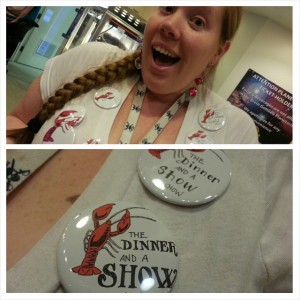
Claude was an instant hit at the KC Fringe. Here’s Dinner and a Show Show friend and lobster advocate Stephanie Davis and her (homemade!) buttons!
From that point on, Benjamin started carrying the lobster (who he affectionately named Claude (get it?!)) everywhere with him. He would introduce him to people; friends, family, strangers, whoever took an interest in the red creature living in his backpack. Eventually, people began to ask, “Where’s Claude?” if he was not immediately visible.
While this crustacean friendship formed, there was an inherent problem with the show: We’d spent zero time in the rehearsal space together. While Benjamin and I had proven we could work well together in the past, the only time our schedules lined up to rehearse was three days before the premiere. To add a little pressure, we were booked at ArtBar – a performing arts bar and venue in St Louis – to do a special “workshop performance” of our piece at the end of this three day period. A little insane, maybe, but we felt it was safer to premiere a nascent version of the show in St Louis for friends than in Kansas City for a real, live paying audience a week later. If something flopped, we could alway rewrite it in Kansas.
Benjamin drove through the night after a gig in Minneapolis, arriving in St Louis in the early morning. Once there, the real work began – our script was a narrative string of dialogue, interspersed with placeholders for routines.
One page, which turned into a solid eight minutes of the show, looked like this:
“Hey hey! I knew we had some wine around here somewhere!”
“Whatever took you so long?”
“I had to go down to the wine seller (cellar).”
“The wine seller on the corner?”
“That’s the one! And he sold me this big box of French champagne!”
((WINE JUGGLING ROUTINE GOES HERE – In the process, waiters discover there is no wine. They go about finding wine together.))
“Hey hey! I knew we had some wine around here somewhere!”
Another page, which turned into the opening fifteen minutes of the show, looked like this:
((Introductory music and jokes play while house is dark.))
((Lights go up, waiters can’t find the restaurant.))
((SETTING THE TABLE ROUTINE GOES HERE.))
“Well, that was much more efficient.”
((Benjamin asks Claude for a joke.))
We had our work cut out for us. Luckily – and, perhaps, weirdly – the ArtBar had a dance studio in the back of it. We camped out there for the next three days to write the juggling acts, learn our lines, rehearse like mad, and through it all – rediscover the trust that had helped us back in January.
In order for a show to feel complete, the performers need to be in synch with one another – trust is very important. Benjamin and I believe that any circus show should be put together so it’s interesting even without any skills at all. That way, it can appeal those familiar with circus and those who aren’t. It might seem counterintuitive for a duo juggling theater show, but the throws and catches are often the last thing to get written down.
We spent the first day on plate juggling, mouthstick, and candle-lighting. The next day was spent hashing out choreography for the acid-flashback / nightmare sequence and finale. There’s not a lot to say about these two days, other than that we put our heads down and started devising material. If I ended up holding a bottle up over my head, where could that sequence go? Where might it go from there? How could we apply intention to those sequences? How does it feel if we do it quickly? Slowly? (Are we spending too much time on this? Let’s run with this choreography and move on to the next bit. We’ll see it it develops futher in Kansas City.)
The third day, of course, was the premiere. We spent that morning running through lines and sequences and the afternoon eating burritos and clearing our heads. The folks at ArtBar cooked up a mess of spaghetti for our audience to enjoy. Our audience got into their cars started driving to ArtBar, unwittingly about to experience the biggest miracle of any of our lives: the show Benjamin and I wrote in such unfavorable conditions didn’t suck.
There were a few drops, for sure. Some lines were missed and some pauses were stepped on. All in all, we were very pleased with how it went. Early on in our plans, I had the idea for a breath-mint and comment-card table in the lobby – a way to get some feedback from the audience, as well as some drop quotes for promotion during the Fringe (and, hey- who doesn’t like a mint after a show!) The reviews were generally quite favorable. Many audience members asked for more juggling. Some folks expressed their love for Claude. Others gave us their phone numbers.
“The ‘Dinner and a Show’ Show” changed quite a bit as the Fringe festival progressed – we found moments to linger on, cut some lines and replaced others with more satisfying improvised moments (“Ring ring. Hello, the idiot store? It’s for you.” “Yes, the idiot store. I will return him right away.”) The piece felt fresh and new each show- thanks in part to a new volunteer each round, thanks in part to the discoveries we made each time we put it up. We added another juggling act after our tech rehearsal, the day before the show opened, too. I’m sure the show will continue to evolve throughout the next year – we’ve got big plans for our little dinner show.
Don’t just take my word for it, though – compare the video from our MoonDrop Circus Open Stage piece to our new trailer. This demo video was created from our fourth showing at the Kansas City Fringe Festival and our teaser performance at the Welcome Show for the International Jugglers’ Association’s 2014 convention. I think you’ll notice a difference!
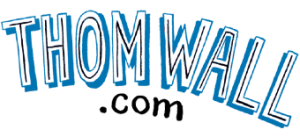
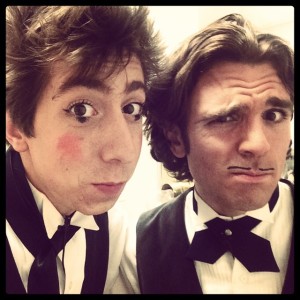
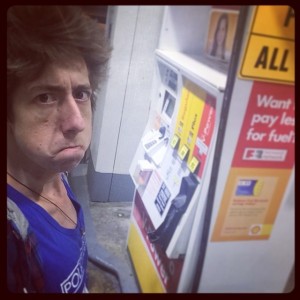
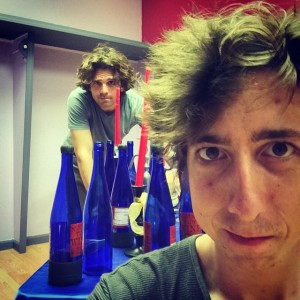
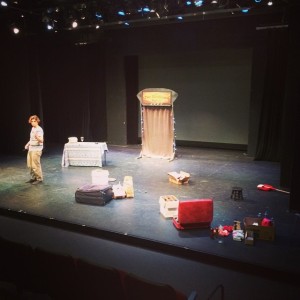
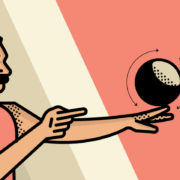


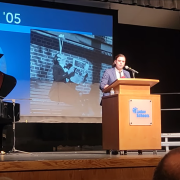
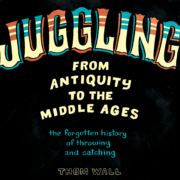
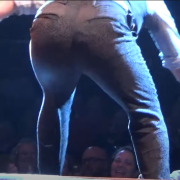


Leave a Reply
Want to join the discussion?Feel free to contribute!